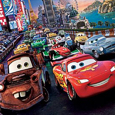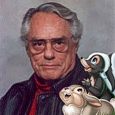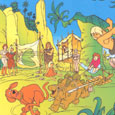Disney/Pixar (June 24 2011), Walt Disney Home Entertainment (November 1 2011), Blu-ray 3D and Blu-ray x2 plus DVD and Digital Copy, 106 mins plus supplements, 1080p high-definition 2.39:1 widescreen, DTS-HD Master Audio 7.1 and 5.1 ES, Rated G, Retail: $49.99
Storyboard:
Mater the tow truck finds himself out of his Radiator Springs comfort zone when he gets mixed up in a slice of international espionage.
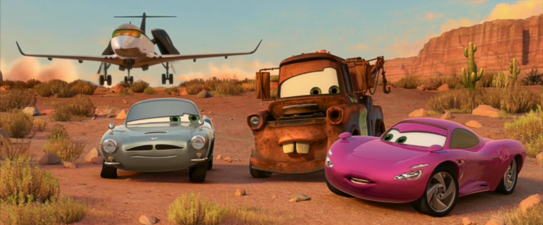
The Sweatbox Review:
Okay, let’s start by getting the huge white elephant in the room out of the way: the world of Pixar’s Cars is just stupid. Without any kind of explanation as to why this world is only populated by – actually it’s not even just cars and should by rights be called “Vehicles” – automobiles, there are way too many inconsistencies to overlook if the world, and by extension these films, want to be taken with any kind of general regard. So what’s the deal? Was there an apocalyptic war to end all wars, rendering all life on the planet dead and only leaving self-powered vehicles to take over? No. There’s no explanation, this is a world only populated by vehicles – primarily cars. And that’s it.
Even coming with Pixar’s impressive track record behind it, I wasn’t ever all that excited to get to grips with the original Cars, a movie whose “great idea” is that cars can live, think and drive for themselves, and eventually didn’t see the film until it came to DVD. Despite not being a huge fan of star vocalist Owen Wilson, he actually won me over, putting in some terrific performance work that surprised me in its direction away from his usual “frat pack” routine. I also somewhat enjoyed director John Lasseter’s take on the frenetic camerawork of TV spots coverage, juxtaposed by the sheer epic scale of the “lost highway” of America along the fabled Route 66 that took us to the hick town of Radiator Springs, where we met the hick tow truck Mater.
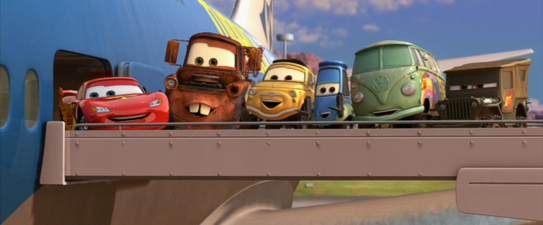
But for all the top-of-the-line sights and sounds, Cars ultimately stalled more than the Lamp’s customary high quality mark would normally indicate, and if Pixar did, at some point in its initial blockbuster run of unqualified hits, have to take a slight dent in their previously meticulous fender, then Cars was it, the film making a lot of money but not receiving the love from fans that have greeted other continuingly popular movies from the Studio. Cars runs out of gas half-way through its longer than usual running time, mostly down to a preachy mid-section and a weaker, more pop-culture than usual-filled storyline, a surprise coming from a company who place such emphasis on such things.
But…whatever side of the road you sat in regards to if you thought Cars was a classic or whether it was a rusty bucket of bolts, Cars spun off the screen and into a huge merchandising phenomenon for Pixar and their soon to be parent Disney Studios. And whatever the artistic intentions of the original movie, there was no denying the Cars cars and toys were driving off the shelves at dangerously high speeds, and that consumer desire needed to be fuelled by more adventures of Lightning McQueen and Mater. Quickly, a series of Cars Toons were put into production: short films that were basically nothing short of commercials for the multitude of additional McQueens and Maters that could be turned into new toys (fire truck Mater, etc)…
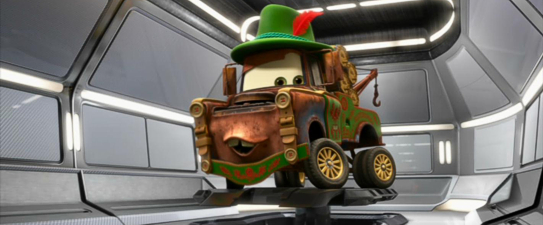
In truth, nine times out of ten, the Cars Toons series could be pretty good fun, focusing on the original Cars movie’s break-out character Mater the tow truck. Especially, the Lasseter-directed Tokyo Mater was a highlight of the series, even earning a place on the bill with Disney’s Bolt in international theaters. And those toys, and the spin-offs of the toys, just kept on selling, although eventually, even though there wasn’t really a call for a second feature film by Pixar fans or the kids buying the toys, one of the Studio’s biggest merchandising franchises needed a boost in terms of making the property visible and fresh again. Naturally, it was time to rev up Cars 2…
There is, of course, never a real reason to produce a sequel apart from the money it can potentially make, and many are merely retreads of the originals. At least in this sense, Pixar has made a film that’s totally different to its predecessor, but, in doing so, has also made something that’s so totally different that it ends up sharing so very little with what came before that there’s not a lot to connect them save returning characters. Coupled with this, the decision to go in a direction that’s more Mater’s Tall Tales from the Cars Toons than the previous film also moves sidekick Mater from the fringes and puts him center stage…and he’s just not that endearing a character to carry an entire feature.
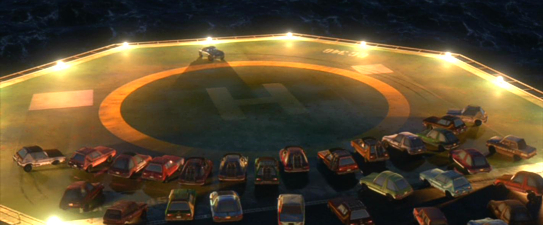
Now, when I heard that Cars 2 had the greenlight, I shrugged and groaned much like anybody, but when details began to emerge about the film being centered around a World Grand Prix that would take Lightning and Mater on a cross-country race around the globe, I thought it actually sounded a lot of fun, bringing back to mind the giant road comedies of the 1960s such as The Great Race, It’s A Mad, Mad, Mad, Mad World and, especially, the global antics of Those Magnificent Men In Their Flying Machines. When more plot points revealed Mater was to be embroiled in some mistaken spy shenanigans, my trepidation turned to anticipation.
There was the danger that the homespun philosophies of the original movie might not have a place in this new, faster-paced, incident-packed thrill-ride to be, although to be honest it was those elements that bogged Cars down in Radiator Springs for me. Not that I didn’t think a Cars 2 needed to ditch it completely, but the early previews indicated this was to be a much more commercially-driven wild ride, with the emphasis clearly on broad, wide entertainment and an shrewd eye on the international audiences who had made the first film such a hit and, more importantly, kept the Cars merchandising machine rolling.
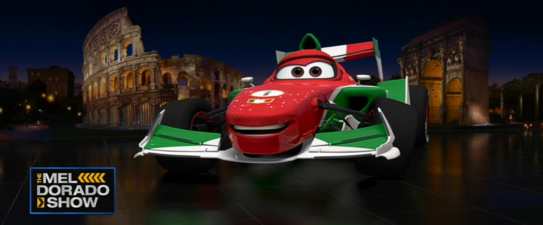
What I wasn’t expecting in the least is that Cars 2 basically throws out everything that was good about the first film and basically feels nothing like what came before at all. Apparently, the origins of the film are to be found in a discarded scene for the first movie, where McQueen and his date Sally were to have visited a drive-in theater and seen a typical 007 movie featuring super-spy Finn McMissile, an Aston Martin, obviously. That moment was switched and cut, but the joke remained in the back of Lasseter’s brain. Perhaps it should have remained just that: a joke for a small moment in a bigger movie, because given an entire film here it gets pretty old very quickly and never feels as fun as the filmmakers seem to think it is.
And that’s Cars 2’s biggest problem: this isn’t a Cars movie at all; it’s not even a Cars Toon stretched out to feature-length, though that’s what it does feel like most. But Cars 2 is essentially a Pixar spy comedy that happens to feature the cars of Cars thrown in as supporting characters, and paradoxically, the supporting character of the original film now given leading status. And who hasn’t, or isn’t, doing spy comedies these days? It’s a sub-genre being done to death, especially in animation, and I had hoped the likes of Hoodwinked Too had killed them off for good. Sadly to say, even with the Pixar touch, it just doesn’t work, the supposedly knowing nods and winks just coming over as tired and overdone clichés, and surprisingly flatly directed by Lasseter and his co-director Brad Lewis.

Lewis was the original director of choice for the film, before Lasseter was reportedly unhappy with some of the direction the movie was headed and stepped in to take the primary director’s credit, with Lewis stepping aside to become “co-director” (why the film couldn’t have been “directed by John Lasseter and Brad Lewis” is anyone’s guess). Lewis, it should be noted, is no longer at Pixar, but I’m surprised Lasseter, his fixes or not, would want to put his name on this kind of openly commercial product in such a primary way. Cars 2 is simply not up to the level of filmmaking that one associates with Lasseter, Pixar or even, it has to be said, the first Cars.
There’s a laziness to the storytelling that I was shocked at, and a lacklustre approach to the direction that captures nothing of the speed and wit of the first film’s clever camera angles. The lack of real excitement in the race scenes is astounding, and practically none of the story points ever really hit home. The “World” Grand Prix is also nothing of the kind either, and the excitement I had at hoping to get caught up in an around the world race was muted by the realisation that this amounts not to a real around the world race on the streets of the world’s major capital cities, but just four races in Tokyo, Paris, Italy and London. That’s not a “World Grand Prix”…that’s what the Formula 1 crews do every year! Where’s the fun and uniqueness in that!?
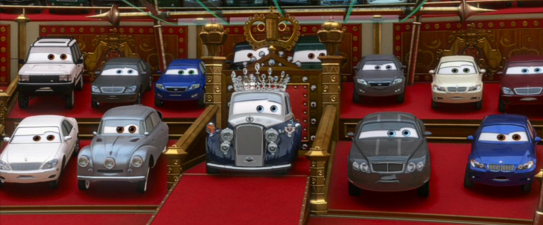
However, these trips to foreign lands – fun as they may be in their Cars-world versions – only play up further fundamental problems with the basic concept, which try as I did to overcome, I just couldn’t. Tokyo looks good, but having already seen it in the Tokyo Mater short it felt like an economical holdover. Paris has none of the authentic feel of Ratatouille, and Italy…well, by Italy I’d done a very rare thing and actually fallen asleep during the movie. In order to give Cars 2 a fair trial, I re-watched it the following evening, where I found myself struggling to keep awake again, my mind only wandering off to such thoughts as, “if they’re cars in a cars world, why does the cars world have sidewalks!?”
Again, the contradictions of the first film got to me, and even if we want to believe that the whole thing is taking place within an alternate automobile world, there are still the crucial questions to be answered: where do these cars came from, who built them and what do they have in their insides if they don’t need seats for us humans to sit in? Why do they have what look like organic mouths and tongues when they are ostensibly machines? And, when Mater is in Paris and comes across a sporty little European car with eyes in its headlamps instead of in the windshield, why does this car have a driver’s wheel!? Who is it for!? This implies the presence of humans, doesn’t it? Where are they? What happened to them? Arrghhh!!???
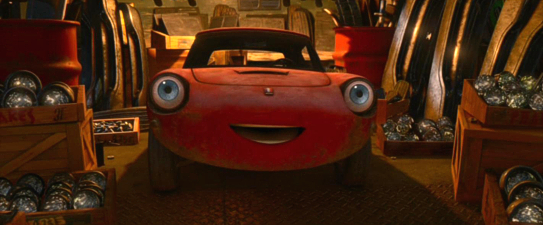
A couple of near-nice elements, including a potential girlfriend for Mater and a train named Stevenson, ultimately don’t break the formulaic and broadly drawn commercial aspirations. Holley Shiftwell may as well be one of Austin Powers’ groovy babes, named as she is so close to one of his conquests (again lazily, she’s an almost-clone of Sally from the first movie), and although the Stevenson pun is a good one, he’s really just there to open the doors to the other vehicles ready to join the Cars team on store shelves, including the characters of the soon to be a franchise of its own, Planes, also teed up in this movie by way of an escape sequence featuring, you guessed it, a plane. So Cars 2 isn’t even just about cars anymore!
Behind the camera, Michael Caine is supposedly witty casting as Finn for having been a spy himself in the seminal anti-spy caper The Ipcress File, also drawing on his cool 1960s persona in the kinds of films that first made him a star at that time. But he’s already paid homage to that past by playing Austin Powers’ Dad in the third film in that franchise, and the joke frankly falls flat. Spy fans may get a brief kick out of the fact Finn proclaims he’s in the import-export business, but it’s a cheap laugh. Likewise with Michael Giacchino’s score, which replaces the soft Americana of Randy Newman’s original music for a blend of high-tech espionage cliché and Bond-style guitar picks. Ho, ho, ho…very droll, me thinks not.

I did think Giacchino – in my opinion not only one of today’s most prolific film score composers but also the most unique and versatile – could do no wrong, but all I could keep thinking about during his Finn McMissile cues was, I’m sorry to bring him up again but, Austin Powers, the Bond pastiche already nailed so completely in those pictures. Here, Giacchino struggles to come up with something that hasn’t been done to death before, failing to ape John Barry’s Bond or the now-standard MediaVentures style of high-pulse rhythmic beats per second orchestral stab-enhanced excuse for action scoring, and not even coming close to the oh so exceptionally fast and loose playfulness of his 1960s inspired The Incredibles and the fantastically vigorous Speed Racer. In fact his score is like the movie itself: whereas The Incredibles brilliantly hinted at Barry/Bond, here the influences spoofed are traded upon lock, stock and barrel.
To be honest, it’s not Giacchino’s fault and he’s probably doing the best he can with the material he’s been given (premium grade Pixar fuel for creativity it is not), as are vocalists Wilson and Larry The Cable Guy, reprising their Lightning and Mater roles respectively. Wilson, though top billed, is hardly in the movie, dumped to second or third tier after Finn, Mater and possibly Shiftwell, an enthusiastic Emily Mortimer, who if nothing else perfectly brings life to her character, though such a shame it’s not in a much better movie. Wilson has had a touch personal life as I understand it recently, and I hope he’s over his troubles, but you wouldn’t know it from this lifeless reading he gives here. Sometimes, I did wonder if it was even him performing McQueen’s lines.
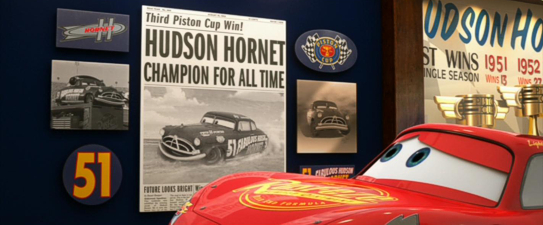
As Mater, Larry basically runs through the usual routine, and some may find it hilarious, but one very good line involving the word “intelligence” in an introduction to McMissile aside, there aren’t really any funny funny lines. Similarly, a supposedly touching tribute to Paul Newman, who voiced the legendary Doc Hudson in the original, doesn’t hit home because there’s no perspective on which to hang it: all we can tell is that the Doc is “gone”, but we’re not even told that, merely that the Piston Cup has been renamed the Hudson Hornet Piston Cup. How come? What happened to the Doc? Did he rust away? What happens to the cars when they die? I get that Lasseter didn’t want to recast the role, but why then draw attention to it? The better thing to do would be to follow the Cars Toons line and simply not reference Hudson, leaving the poignant memory of the original tribute enough to a one of a kind performer.
Also unlike the Cars Toons – which for some reason makes the cars notion really work in a short form format that doesn’t beg the wider questions that a movie demands – the Cars concept is stretched to the limit here by the story requirements where the cars need to do much more than just drive around and talk. Props must be handled, and so there’s a much greater reliance on the characters’ wheels being used as hands, while further still are a variety of sticks and pokers that come into play way too much as a too convenient option for the filmmakers to lazily fall back and rely on. And again the underlying basics of the concept is questioned when one character points out that fossil fuel is surely going the way of the dinosaurs. Shouldn’t that have been “dinocars”?
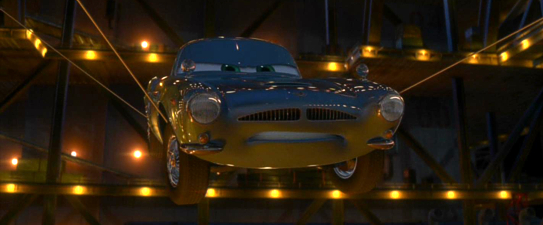
Along these lines, some may find the occasional mentions of “alternate fuel” solutions to be the film’s hidden message, but – even if it turns out to be a ruse – it actually ends up presenting such renewable power as a dangerous exchange. This isn’t the only area in which Cars 2 seems to be confused: it just doesn’t know if it’s a racing sequel to the original, or a new spy adventure that happens to feature the Cars characters. Reaching between the two extremes, it’s certainly neither one successfully, as if two different movies are playing and we keep switching between the two before the characters start to cross over.
The promise of an around the world race flops under the primary secret agent plot, the chance to visit various countries of the world restricted to just four locations, and even then Paris gets a scant five minutes due to a race being cut from those moments. The final moments in London and an escape from a Big Bentley clock might have been considered fun or even exciting had they not resorted to tried, and tired, clichés that just don’t bring any energy to the scenes, and the ultimate denouement falls flat without any suspense, simply again a real shocker when one considers whose name is attached as the director of the film. And, coming after Toy Story 3 it’s unfortunate that Cars 2 is the second sequel from Pixar in a row, undoubtedly tarnishing the name in definitely not being able to stand up next to that film or even the original Cars.
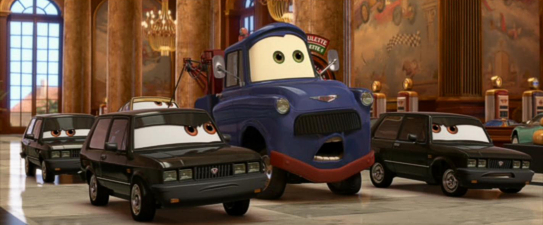
Which is what makes it all so frustrating! The elements should work: Mater gets caught up in the secret agent plot in classic mistaken identity Hitchcock fashion, some of the action can be involving, and some vocal cameos might raise a quick smirk. But then we have an all-too obvious villain whose scheme would have surely been rumbled after two too many cars blew their engines in the first couple of races, those race scenes are oddly non-involving, and there are some frankly strange and dubious gags: Mater going to the toilet, for instance, just feels so wrong and unfunny, and this is just it – this is a Pixar feature we’re supposed to be watching for goodness’ sake, not a near-the-mark, anything goes and ever so slightly crude DreamWorks movie. And this is Cars 2’s biggest disappointment: that this is a Pixar movie.
Coming from any other Studio, the original Cars may well have not been as well received as it was without the Lamp’s branding behind it, but if it had warranted a sequel it may well have been accepted as a perfectly harmless piece of commercial entertainment. But those words are not what one would normally associate with this particular Studio, and even given the eccentric Cars concept the potential of a world grand prix coupled with a classic mistaken identity spy plot just isn’t reached, the filmmakers seeming to believe they can get away with simply producing a stretched out, feature-length edition of Mater’s Tall Tales in order to keep selling the toys. Well, they can’t: as a major piece of filmmaking, it doesn’t even make it into gear. Like the world they inhabit, Cars 2 is a stupid movie.
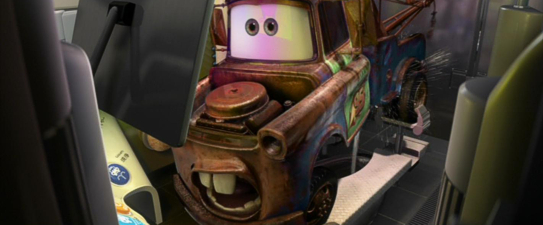
Is This Thing Loaded?
Cars 2 comes to home video disc in the usual variety of configurations, but it’s the premium five-disc combo pack that we’re looking at here, some of the various discs of which can be found in separate Blu-ray and DVD packs. At first glance, you’d think there’s a heck of material been assembled to support the film on disc, but as with many films that went through overhauls part way through production, there isn’t as much insight as you might be hoping for, and there’s even the sense of scraping the barrel with some of the content. On the Blu-ray 3D disc, we do actually get a bonus, the Cars Toons short Air Mater in 3D, which is a nice touch, but why no Hawaiian Vacation too?
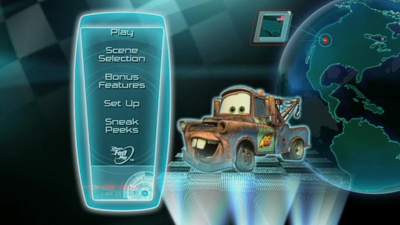
On the Blu-ray Disc (and the bundled-in DVD), the chief extra is the feature-length Audio Commentary with directors John Lasseter and Brad Lewis. Lasseter absolutely dominates the conversation, into which Lewis seems to have been inserted into later, and the first half of it isn’t too bad. There’s none of the expected Cine-Explore picture-in-picture extras to enjoy while the talk goes on, but Lasseter explains the origins of the concept and some of the developmental ideas, while Lewis actually makes more of the prescient plot and character points. However, the second half of the film sees the chatter melt into a series of comments on how “cool” this or that was, and largely falls into the pitfall of simply describing what’s happening on screen. Like the film, surprisingly lacking.

The aforementioned Cars Toons short Air Mater is also included here (and on the DVD), and although I much prefer the Toons format for the Cars characters – just think how cool that might have been if Cars had just been reserved as an ongoing series of shorts? – this isn’t the best of them and feels exactly like the basic promotional film for the upcoming Planes spin-off that it is. Here, the usual format is recycled: Mater tells one of his tall tales about how he once learned to fly and got so good he appeared in an air show, with Lightning doubting everything until Mater inserts him into his story.

But, basically and despite some really nice aerial animated action, it’s just another excuse to plug the Planes movie coming in 2013 – Mater even closes the short by suggesting something along the lines of “someone should make a movie about planes, you know, Planes?”, which is about as openly blatant remark as could be made. Playing with Cars 2 in theaters, and as a semi-mini-sequel to Toy Story 3, the first in a new series of Toy Story Toons: Hawaiian Vacation is also included (also on the DVD), and quickly becomes the highlight of the entire set! When their new owner is off on holiday, Ken and Barbie plan the ultimate getaway, though when their plans don’t take off as expected, Woody, Buzz and the gang pitch in to make it a vacation to remember.

Directed by Gary Rydstrom, it’s an instantly likeable short that returns to the basic elements of fun that were largely suppressed by the third feature film, with the kind of mood that I really hope is retained if a rumored Toy Story 4 does happen. Here the characters have lost their mortality-dwelling funk and are clearly enjoying their new home, a fundamental foundation on which to build another film. Not only this, but there are some great gags, both in the animation and from the vocal performances by a returning cast that includes Tom Hanks, Tim Allen et al, though I do hope that Spanish Buzz isn’t now going to become a mainstay gag in further outings…it was a desperate laugh in the third film and just won’t get any funnier.
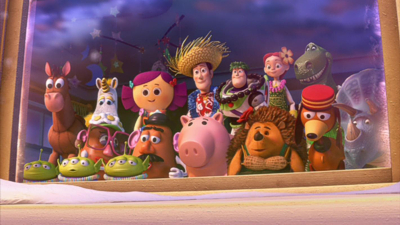
On to Disc Two, and although the promise of an Around The World Tour where one can “choose your own adventure with interactive access to deleted scenes, documentaries, animation and more” sounds really cool, it’s actually a very basic map of the world that groups the supplements under various countries visited (and not visited, actually) in the movie. In fact, I thought the way we circumnavigate the globe should have been in the opposite direction so as to more closely follow the course of the movie’s locations, since as a result we view material on the London climax almost immediately and end in Tokyo, where the film begins! Hmmm… The best way to watch it all is via the world map, where we travel from the Pacific through Emeryville and Europe until we get to our final destination. It sounds like it’s going to be a long trip, but the scarcity of the depth in what’s on offer is just another surprise in this sub-standard for Pixar effort.
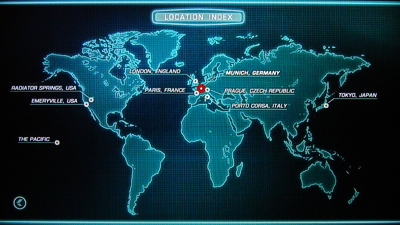
Topping the list – and actually quite good – is a Sneak Peek at The Nuts And Bolts Of Cars Land (6:45), in which Pixar good luck charm John Ratzenberger visits Disneyland California to witness the beginnings of the development of the park’s first new Land in quite some time. Although this is nothing but promotion for the summer 2012 attraction, it’s actually very interesting to see how such things are constructed, including the Radiator Springs scenery, how the ideas are taken from concept to realization, and the new-twist resurrection of a classic Disneyland ride. Somewhere In the Pacific (3:34) goes to lengths to express that the intention was to make a movie that was anything but Cars but quickly drops into an exploration of the effects work which, while it obviously looks great, is too routine when every new animated movie stresses to say how better their water or fire is than the last one.
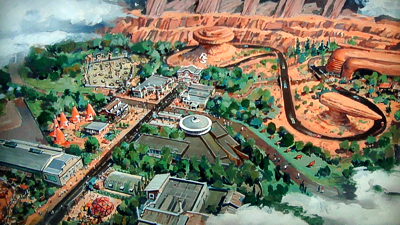
Making Lemon-Aides (4:02) casts the light on Cars 2’s villains, explaining the “lemon” term in regards to poorly performing vehicles and the thinking behind their plan to give themselves more power in the Cars, but be spoiler aware and know that the “mystery mastermind” is revealed. An Oil Derrick Set Exploration sounds cool, but is merely a 21-second flythrough shot of the location, the first of many offerings that feel like they’re scraping the (oil) barrels. An Art Slideshow (also accessible from the other locations) is a gallery offering of development art for the movie, including a very cool Finn McMissile poster which is really how the film should have been sold.
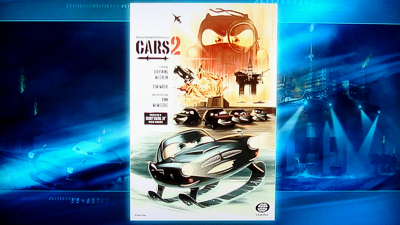
In Emeryville, Motorama (7:38) reveals the annual private Pixar staff car show at which various classic vehicles and wrecks in progress of being restored are brought to be admired by their other colleagues. It all looks fun, especially if you’re well into your cars, but also a bit like standing on the outside looking in on a party that you’re not invited to. He Lives! Making The Finn McMissile Toy (3:47) manages to just about find a balance between remaining artistic and selling out completely, and although there’s a lot of talk about Finn’s role in the movie, it’s clear a lot of his appeal to the filmmakers was in the different models that could be produced. Animation Pit Stop (4:16) gathers a number of publicity interstitials, while a US Domestic Teaser and Trailer (1:30 and 2:30 respectively) are self explanatory but welcome inclusions.
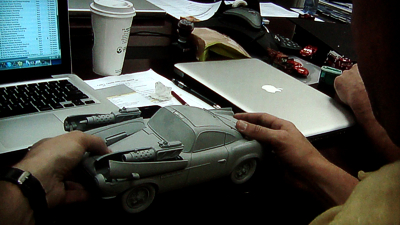
In Radiator Springs (which seems to swap places between the globe and the world map menus!), Deleted Scene: Tall Tale (3:34) further strengthens the connection between Cars 2 and the Mater’s Tall Tales tone, pulling the movie back towards being a Cars sequel as opposed to a spy-thriller with cars. The Origins Of Cars 2 (6:03) is actually only half about the sequel and more about how personal the original Cars was to Lasseter combined with a paean to the inspiring Route 66. The director does repeat some information from his commentary, but there’s also some nice insight from him too. A Radiator Springs Set Exploration is another brief flythrough (:29) and another Art Slideshow link offers up more concept work.
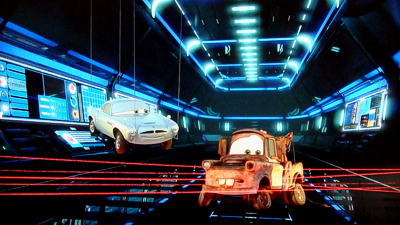
In London, Brawl At Big Bentley (5:28) deals not with how the final escape and chase was staged, but instead how this major city was built and populated for the all-important closing scenes. This is actually pretty interesting, not only for the amazing way Pixar wrote software that would “grow” buildings but also for the look into their painstaking processes to convey native detail to each region depicted in the movie. Spyfied (6:27) elaborates on the British agents’ gadgets and communicative methods, another angle that shows the level of Pixar detail, including a peek at the original McMissile idea created for the first Cars. Without context, I’m not sure what the 46-second Spy Training: London clip was intended for, but it’s quite fun, while there are more Set Explorations for Big Bentley, Tower Bridge, the London Eye and Buckingham Palace (:43 total) and there’s the UK Theatrical Trailer (:30) and another Art Slideshow link.

Hopping over to Europe and, in Paris, the Paris Race: Deleted Scene (5:58) really could have done with being in the movie as it’s exactly the kind of street race that I’d been hoping the World Grand Prix would have been composed of. I can see why it was cut, but surely other moments could have been trimmed to help the film feel more like the Cars sequel it ostensibly is supposed to be. At 4:32, Streets Of Paris is almost as long as the film’s French capital-set sequence, for which the amount of work seen going into it here seems an awful waste. Spy Training: Paris is another publicity clip, and there are three more Set Explorations for the Arc de Triomphe, Eiffel Tower and the Paris Market (:37 in all), and another Art Slideshow link.
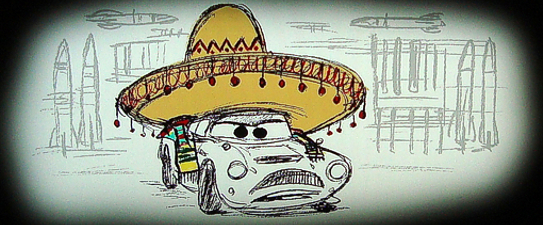
The Cars 2 gang don’t actually visit Munich in the film, but they were intended to, as a Germany: Deleted Scene (2:36) reveals. Another moment cut for length when it actually looks more interesting than some elements that wound up in the movie, this could have brought further visual variety to the film. The same could be said for the Oktoberfest: Deleted Scene that has fun with German traditions and presents a more appealing version of one moment that did make it to the final film as well as an amusing Pirates Of The Caribbean gag. A nine-second Mater-hosen joke is the set’s biggest laugh, and for good measure (if you want to call it that) there’s the German Theatrical Trailer (1:58) and the Art Slideshow link again.
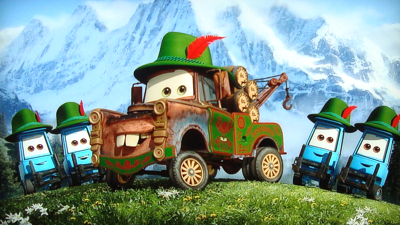
A Prague Chase: Alternate Opening (2:57) is all we get in the Czech Republic location (though it has better spy credentials than the resulting oil rig opening), as well as another Art Slideshow link, but in Italy’s Porto Corsa there’s a good look at the location trip that inspired this fictional racing city in Finding Porta Corsa (7:31) and the development of that sequence. The Heart Of Italy (4:15) explores the Italian scenes further, in particular Luigi and Guido’s home town that they visit on their tour. International Insurance has no context and no meaning, being an odd 15-second animated clip, and there are Set Explorations for Uncle Topolino’s (a nice in-joke name for Disney buffs!) Square and Porta Corsa (:33 total).

Finally in Tokyo (where the film essentially begins), we end our journey with the Tokyo Race: Lap One Extended Scene, which features optional comments from the technical filmmakers and some terrific low angle car shots that are much more involving than what ended up in the movie. Mater Takes Tokyo (4:55) looks not at how popular the character is in Japan, but at the work that went into these scenes, but by now the point of how much detail goes into each location has been made and it does seem like a case of “same stuff, different place”. Many Nations: One Race (7:05) wraps up the concept and ideas of the film, though I still can’t help but feeling a straight “around the world” race would have been so much more entertaining and might even have melded with the spy plotting more.
Spy Training: Tokyo (:41) is another context-less publicity clip, there’s the Japanese Theatrical Trailer (2:05) and a final Museum Set Exploration (:11) and Art Slideshow link rounds things up. Some Menu Easter Eggs (hit up and down on the various Disc Two options to locate them) just about add enough extra dregs (more on how Cars 2 is like the “anti-Cars”, supporting character explorations, deleted scenes and an entire extra Moscow location that contains the Russian Theatrical Trailer) to make it over the finish line, but it’s a shame Cars 2’s trunk isn’t any bigger, since that’s all this set’s luggage space can hold.
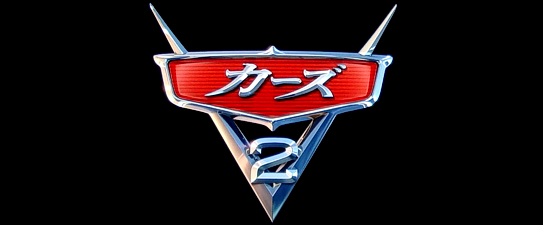
The main supplements are short and sometimes irreverent at best – at times it seems there are a lot of bullet points that could have otherwise been grouped more neatly – and while the location flythroughs would be super cool as additional little extras in a bonus-packed selection, they seem like stretches in terms of the producers searching for things to fill the disc. Likewise with the theatrical trailers, for a long while a no-show on Disney sets, and now seemingly included just to make up the numbers. And, while I do get that Cars 2’s around the world travels makes sense to include the foreign trailers, that does seem pushing it even further in a package that just feels too light and inconsequential – hey, like the movie!
Case Study:
If, unlike me, you loved Cars 2, then the 3D combo pack is the one to go for if only for the 3D lenticular card stuck to the front of Disney’s slipcovered artwork. Not only does it use a much nicer theatrical poster as its main image, but there are several nice layers of depth to it that makes up one of the best such sleeves I’ve seen for a while. If, like me, you don’t like the movie, you still can’t fail to be even the slightest bit impressed with this, even if the detail of the locations is better appreciated on the sharper paper sleeve replicated in the thick BD case underneath. Inside there’s a ton of promotional advertising for Disney and Cars product, including a Movie Rewards exclusive offer of a collectible Cars 2 Lunch Box and the concurrent release of the Toy Story trilogy on Blu-ray 3D.
Ink And Paint:
Blu-ray 3D: It’s not, actually, too unfair to say that the best thing about Cars 2 is the end credits – and this is a compliment! Not only do they signal the end of this vastly disappointing movie, but Pixar artist Andrew Jimenez’s decorative titles, coupled with the catchy, ’specially written “them and us” anthem Collision Of Worlds by Brad Paisley and Robbie Williams, are among the most entertaining minutes of the film, hinting at so many of the additional countries that the film would have inevitably been much better for visiting. In addition to the enjoyment factor, this “scrapbook” tour of the world has a wonderfully layered 3D effect to it that does something with the otherwise flat credits that adorn most extra-dimensional movies.
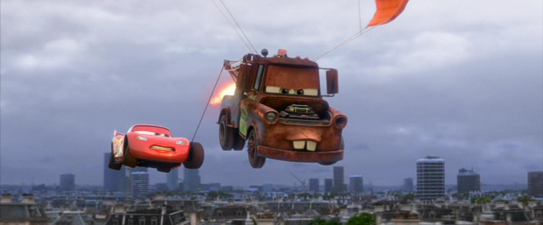
That aside, the rest of the 3D of Cars 2 just didn’t really do anything for me, proving that a visual gimmick can’t help a bad picture be any better even though a good film can sometimes find itself further benefited by the process – though these are few and very far between. Here, the 3D is as flat as the direction, again a surprise and especially after what has been achieved in CG animation by Disney’s Tangled, overseen by Lasseter, and by Pixar themselves in the retro-converted reissues of Lasseter’s original two Toy Story movies. Whereas those films had a pop and fizz that enabled the 3D to add some fun, Cars 2 is just too laborious and the potential for some really cool high-speed enhancement is missed, feeling oddly pedestrian for a film with so much supposed action.
Blu-ray Disc: Just as one would expect of a Pixar movie, whatever its overall entertainment value, Cars 2 is as detailed and packed with meticulous touches as to suggest these kinds of films were what the hi-def format really has been invented for. Top among some of the freeze-frame gags to pick out and enjoy is a drive-in theater playing “The Incredimobiles”, while the textures of the characters and the landscapes are as remarkable as always. The image isn’t overly bright, either, somewhat helping the nuts Cars world mirror our own more, and contrast is good (the neon of Tokyo, the softness of Paris, the color of London), while the crushed blacks of Mater’s dream sequence are as a deep and non-inhibited by noise or compression as they should be. In fact, it’s a very impressive transfer of a very mediocre movie.

Scratch Tracks:
Presented in an overkill of audio options, from the DTS-MA 7.1 theatrical track and a DTS-MA 5.1 home theater mix, to a Dolby 5.1 EX version and a Dolby 2.0 mix for those watching on regular televisions, one has to wonder if Pixar are a little obsessed when it comes to their soundtracks. The options (across the BDs and the DVD) are welcome, but surely it’s only technophiles that are going to bother to switch from anything but the defaults…and they’re more than likely to be watching on full speaker surround systems anyway!
The abundance of soundtrack tracks means certain languages get lost in translation between the American and Canadian releases: both get English, natch, but America gets two flavors of Spanish, and Canada gets French dubs and subs. Of the quick checks I made between a few of them, all were expectedly up to scratch, the main DTS 7.1 mix being the obvious standout, though I was surprised at how lacking in energy Giacchino’s score was, especially mixed way back into the soundfield at times.
Final Cut:
If Cars was the movie on which Pixar took a bit of a knock, then Cars 2 is the one that has driven them right off the road. With each and every new Pixar film, doom is predicted for the Studio by almost every critic suggesting that the next release will be the one to break their undisputed streak of box-office hits. Well, guess what? As lame, blandly safe and commercial as Cars 2’s feature-length promo for some hugely popular toy vehicles is, it still made a chunk of change in theaters and is likely, whatever the word of mouth, to do well enough on home video. Will there be a Cars 3? We can certainly hope not, even if it is already on the way somewhat, via the Planes spin-off franchise in waiting. I’m kind of looking forward to that, but I do hope we’ve seen the last of Mater and company for now: anything further is just a car crash waiting to happen.
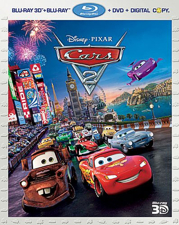 | ||
 |


